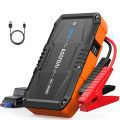In a world where darkness can often feel isolating or intimidating, night vision goggles offer a transformative solution that enhances our ability to see and interact with our surroundings. Whether you’re an outdoor enthusiast, a security professional, or simply curious about the technology behind these remarkable devices, understanding night vision can empower you to make informed decisions. In this blog post, we will delve into the intricacies of night vision technology, explore its various applications, and guide you through the essential factors to consider when selecting the perfect pair of goggles. Join us as we illuminate the fascinating world of night vision and help you navigate the night with confidence.



How Night Vision Works
Night vision technology has revolutionized the way we see in low-light conditions. Whether used for military applications, wildlife observation, or even home security, understanding how night vision systems operate can help users choose the right equipment for their needs. This section will delve into the science behind night vision, exploring the primary types of systems: image intensification and thermal imaging.
Image Intensification: Amplifying Available Light
Image intensification (I2) is a widely used technology that enhances existing light to allow for nighttime visibility. This system works by gathering ambient light, such as moonlight or starlight, and amplifying it to create a visible image.
How it Works
- Light Collection: The image intensification device collects available light through a lens.
- Photocathode: The light strikes a photocathode, which converts the photons (light particles) into electrons.
- Electron Amplification: These electrons are then accelerated through a vacuum tube, passing through a series of microchannel plates that multiply their number—often by several thousand times.
- Image Formation: The amplified electrons strike a phosphor screen, creating a visible image that the user can see through the eyepiece.
Key Features
- Low-Light Performance: Effective in conditions with minimal light.
- Color Images: Some advanced systems provide color images, enhancing detail.
- Compact Design: Many devices, like the ATN PVS7, are lightweight and portable.
Popular Image Intensification Products
- ATN PVS7: A popular choice among military and law enforcement, this system offers rugged durability and clear images in low light.
- FLIR Photon RT: A compact thermal monocular that is great for spotting animals at night.
Thermal Imaging: Detecting Heat Signatures
Unlike image intensification, which relies on ambient light, thermal imaging detects heat emitted by objects and living beings. This technology is invaluable in complete darkness or when visibility is hindered by smoke, fog, or other environmental factors.
How it Works
- Heat Detection: Thermal cameras use infrared sensors to detect heat energy emitted by objects.
- Signal Processing: The detected heat is then converted into electronic signals.
- Image Creation: These signals are processed and displayed as images, with warmer objects typically appearing in brighter shades (e.g., red or yellow) and cooler objects in darker shades (e.g., blue or black).
Key Features
- Full Darkness Functionality: Operates effectively without any light source.
- Wide Range of Applications: Useful for search and rescue, wildlife observation, and surveillance.
- Durability: Many thermal devices are designed for rugged environments.
Popular Thermal Imaging Products
- FLIR Scout TK: A compact and affordable thermal monocular perfect for outdoor adventures and scouting.
- Pulsar Thermion XQ38: Designed for hunting, this thermal scope offers high-resolution imaging and advanced features.
Comparison of Night Vision Technologies
Here’s a quick comparison of image intensification and thermal imaging to highlight their distinct advantages:
| Feature | Image Intensification | Thermal Imaging |
|---|---|---|
| Light Requirement | Requires some ambient light | Functions in complete darkness |
| Image Type | Greyscale or color (depending on model) | Heat signature representation |
| Best Use Cases | Nighttime navigation, tactical operations | Search and rescue, wildlife monitoring |
| Cost Range | Generally more affordable | Typically more expensive |
| Portability | Generally compact | Varies by model, can be bulky |
Practical Applications of Night Vision Technology
Military and Law Enforcement
Night vision is essential for tactical operations, allowing soldiers and officers to operate effectively in low-light conditions. Devices like the AN/PVS-14 provide excellent visibility while maintaining a compact size.
Wildlife Observation
For wildlife enthusiasts, thermal imaging offers the ability to observe animals without disturbing their natural behavior. The FLIR Lepton is a highly portable thermal camera that can be used for casual wildlife spotting.
Home Security
In home security, night vision cameras are crucial for monitoring properties after dark. Brands like Arlo offer night vision capabilities in their outdoor security cameras, providing peace of mind even in low-light conditions.
By understanding the mechanisms and practical applications of night vision technology, users can make informed decisions on which systems best suit their needs, whether for personal use, professional applications, or recreational activities.
Types of Night Vision Goggles
When it comes to choosing the right night vision goggles (NVGs), understanding the different generations available is crucial. Each generation offers unique features, performance levels, and price points. This section will delve into the specifics of Gen 1, Gen 2, and Gen 3 night vision goggles, equipping you with the knowledge needed to make an informed decision.
Generation 1 (Gen 1) Night Vision Goggles
Overview
Gen 1 night vision technology has been around since the 1960s and is often the most affordable option on the market. These goggles are great for casual use, such as wildlife observation or nighttime hiking.
Performance
- Resolution: Typically offers a resolution of around 30-40 lines per millimeter.
- Range: Effective in low-light conditions, usually up to 100 yards.
- Image Quality: A bit grainy and lacks clarity compared to later generations.
Durability
- Construction: Generally made from lower-quality materials, which might not withstand harsh conditions.
- Lifespan: Can be less durable and often have a shorter lifespan, usually around 500-1,000 hours of use.
Price
- Cost Range: Generally priced between $200 to $600.
Example Models
- ATN PVS-14: A popular choice for beginners; offers decent performance for the price.
- Sightmark Ghost Hunter 1×24: Affordable and user-friendly, suitable for casual observation.
Generation 2 (Gen 2) Night Vision Goggles
Overview
Gen 2 goggles are a step up from Gen 1, featuring improved image quality and enhanced performance. They are suitable for serious outdoor enthusiasts and professional applications.
Performance
- Resolution: Offers resolution levels of 50-60 lines per millimeter.
- Range: Effective up to 200 yards in low-light conditions.
- Image Quality: Provides a clearer, brighter image with less distortion and grain.
Durability
- Construction: More robust materials, often featuring weather-resistant designs.
- Lifespan: Typically lasts about 3,000 hours of use.
Price
- Cost Range: Generally priced between $600 to $2,000.
Example Models
- Armasight PVS-14: Known for its versatility and high-quality optics, suitable for both recreational and tactical use.
- ATN NVM14: Compact and lightweight, offering excellent performance for both civilian and military applications.
Generation 3 (Gen 3) Night Vision Goggles
Overview
Gen 3 goggles represent the pinnacle of night vision technology, used by military and law enforcement professionals around the world. They offer the highest performance and durability.
Performance
- Resolution: Capable of 70-80 lines per millimeter, providing crystal-clear images.
- Range: Effective up to 300 yards or more, even in extremely low light.
- Image Quality: Superior clarity and brightness, with minimal distortion and noise.
Durability
- Construction: Built with high-quality materials designed to withstand extreme conditions.
- Lifespan: Lasting around 10,000 hours of use, making them highly reliable.
Price
- Cost Range: Generally priced between $2,000 to $8,000, reflecting their advanced technology and capabilities.
Example Models
- FLIR PVS-7: A well-regarded choice for professionals, featuring rugged construction and outstanding optical performance.
- L3Harris AN/PVS-14: Known for its durability and versatility, often used in military operations.
Comparison Table
| Feature | Gen 1 | Gen 2 | Gen 3 |
|---|---|---|---|
| Resolution | 30-40 lines/mm | 50-60 lines/mm | 70-80 lines/mm |
| Effective Range | Up to 100 yards | Up to 200 yards | Up to 300 yards |
| Image Quality | Grainy | Clearer, brighter | Superior clarity |
| Lifespan | 500-1,000 hours | 3,000 hours | 10,000 hours |
| Price Range | $200 – $600 | $600 – $2,000 | $2,000 – $8,000 |
Understanding these differences in night vision technology will help you select the right goggles based on your specific needs, whether for casual use, adventure, or professional applications.
Applications of Night Vision Goggles
Night vision goggles (NVGs) have transformed the way various sectors operate in low-light conditions. With advanced technology that amplifies available light, these devices provide enhanced visibility and situational awareness, making them indispensable in several applications. Here, we explore the diverse uses of night vision goggles across different fields, highlighting specific products and their benefits.
Military and Defense
The military is perhaps the most well-known user of night vision technology. Night vision goggles provide soldiers with the ability to conduct operations under the cover of darkness, ensuring tactical advantages over adversaries.
Key Features:
- Image Intensification: NVGs like the AN/PVS-14 utilize image intensification technology, allowing soldiers to see in near-total darkness.
- Durability: Models such as the L3 Harris BNVD-1531 are built to withstand harsh environments, ensuring reliability in combat situations.
Benefits:
- Enhanced situational awareness during nighttime missions.
- Ability to navigate and engage targets without the need for artificial lighting.
Law Enforcement
Law enforcement agencies employ night vision goggles for surveillance, search and rescue operations, and tactical responses to incidents occurring after dark.
Practical Examples:
- The ATN PVS7-3 is commonly used by police forces for patrolling urban areas at night.
- Many agencies utilize the FLIR Breach PTQ136, which offers thermal imaging capabilities for locating suspects or missing persons in low visibility.
Benefits:
- Improved safety for officers during nighttime operations.
- Enhanced capability to monitor and respond to incidents discreetly.
Wildlife Observation
For wildlife enthusiasts and researchers, night vision goggles provide a unique opportunity to observe nocturnal animals without disturbing their natural behavior.
Examples of Use:
- The Night Owl Pro Nexgen series is popular among wildlife observers for its lightweight design and clear imaging capability.
- Nature preserves and research projects often use the Bushnell Equinox Z for its video recording feature, allowing for documentation of wildlife activity.
Benefits:
- Enables observation of elusive species that are active at night.
- Allows researchers to collect data without the influence of artificial lights.
Hunting
Hunters leverage night vision goggles to enhance their experience and success rate during nocturnal hunts.
Recommended Products:
- The Sightmark Ghost Hunter 2×24 is favored for its affordability and effectiveness, making it accessible for casual hunters.
- The high-end Pulsar Edge GS 1.5×21 provides superior performance in low-light conditions, allowing for long-range visibility.
Benefits:
- Increased accuracy when hunting at night.
- Better tracking of game movements in darkness.
Search and Rescue Operations
Night vision technology plays a crucial role in search and rescue missions, enabling teams to locate missing persons or conduct emergency rescues in low-light environments.
Equipment Used:
- The ATN NVM14-3 is a versatile model often used in SAR operations due to its compact size and reliability.
- Many teams also utilize the FLIR Scout III thermal monocular for heat signature detection, essential for finding individuals in dense terrain.
Benefits:
- Significantly reduces the time needed to locate individuals in the dark.
- Enhances the safety of rescue personnel during nighttime operations.
Summary of Benefits
| Application | Key Products | Key Benefits |
|---|---|---|
| Military | AN/PVS-14, L3 Harris BNVD-1531 | Tactical advantage, enhanced situational awareness |
| Law Enforcement | ATN PVS7-3, FLIR Breach PTQ136 | Improved officer safety, discreet surveillance |
| Wildlife Observation | Night Owl Pro Nexgen, Bushnell Equinox Z | Non-invasive observation, data collection |
| Hunting | Sightmark Ghost Hunter 2×24, Pulsar Edge GS 1.5×21 | Increased accuracy, better tracking |
| Search and Rescue | ATN NVM14-3, FLIR Scout III | Faster location of individuals, enhanced safety |
The versatility of night vision goggles across these applications highlights their importance in modern operations, enhancing safety, effectiveness, and overall performance in various challenging environments.
Key Takeaways and Future Insights
In conclusion, understanding night vision goggles is essential for anyone considering their use for recreational activities, professional applications, or security purposes. Throughout this post, we explored the fundamental principles of night vision technology, the different types of goggles available, and their specific features and benefits. As you assess your needs, remember to consider factors such as intended use, budget, and desired performance. By aligning these requirements with the right features, you can select the best night vision goggles that suit your unique situation. Whether for wildlife observation, tactical operations, or simply enhancing your nighttime adventures, informed choices will enhance your experience and effectiveness in low-light conditions.










I’d love to see an article focused on the best night vision gear for hunting. It’s such a crucial aspect for us hunters!
Has anyone experienced issues with distortion in their night vision goggles? I’ve read some models struggle with that.
Distortion can definitely be an issue with lower-end models. It’s usually better to invest in higher-quality optics to avoid that problem.
What about the legalities of using night vision goggles in certain areas? I’ve heard some places have restrictions. Can anyone clarify?
That’s a valid concern! Regulations can vary widely depending on where you live. It’s always good to check local laws before using them.
For anyone thinking about getting into night vision, I’d recommend the Bushnell Night Vision 260130. It’s affordable and decent for beginners!
Thanks for the recommendation! It’s always helpful to have budget-friendly options for those just starting out.
I recently got a pair of FLIR LS-XR thermal goggles for wildlife watching at night. The heat signatures are super cool! Anyone tried something similar?
That’s awesome! Thermal imaging really opens up a whole new world for observing wildlife. Have you spotted anything interesting?
I’ve been using the ATN PVS7 Night Vision Goggles for a couple of years now, and they work like a charm! Perfect for my night hikes. Anyone else had a good experience with them?
I wish the article had touched on the battery life of different models. It’s such a bummer when you’re out and suddenly run out of juice!
Great point! Battery life can definitely make or break a night out. I’ll consider adding that in a future update!
I once went on a night mission with some friends using night vision goggles and spotted a family of deer! It was thrilling! Night vision is such a game-changer.
Does anyone have tips on how to clean night vision goggles? I want to make sure mine last as long as possible without scratches!
Great question! Using a microfiber cloth and a lens cleaning solution is usually the best way to keep them in top shape. Just be gentle!